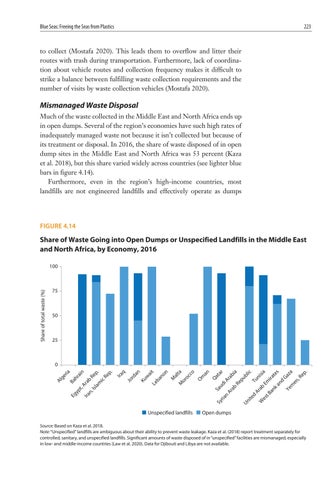Blue Seas: Freeing the Seas from Plastics
223
to collect (Mostafa 2020). This leads them to overflow and litter their routes with trash during transportation. Furthermore, lack of coordination about vehicle routes and collection frequency makes it difficult to strike a balance between fulfilling waste collection requirements and the number of visits by waste collection vehicles (Mostafa 2020).
Mismanaged Waste Disposal Much of the waste collected in the Middle East and North Africa ends up in open dumps. Several of the region’s economies have such high rates of inadequately managed waste not because it isn’t collected but because of its treatment or disposal. In 2016, the share of waste disposed of in open dump sites in the Middle East and North Africa was 53 percent (Kaza et al. 2018), but this share varied widely across countries (see lighter blue bars in figure 4.14). Furthermore, even in the region’s high-income countries, most landfills are not engineered landfills and effectively operate as dumps
FIGURE 4.14
Share of Waste Going into Open Dumps or Unspecified Landfills in the Middle East and North Africa, by Economy, 2016
Share of total waste (%)
100
75
50
25
al ta or oc co Om an Qa Sa Sy ud tar ria iA n r Ar ab abia Re pu Un bl ic ite d Tu Ar n isi ab W a es t B Em ira an te ka nd s Ga Ye za m en ,R ep .
M
M
no n
ai t
ba
w
Le
q
an
Ku
rd Jo
p.
Ira
p.
Re ic
Re
Ira
n,
Isl
am
ai n
Ar ab
Ba hr Eg
yp
t,
Al
ge ria
0
Unspecified landfills
Open dumps
Source: Based on Kaza et al. 2018. Note: “Unspecified” landfills are ambiguous about their ability to prevent waste leakage. Kaza et al. (2018) report treatment separately for controlled, sanitary, and unspecified landfills. Significant amounts of waste disposed of in “unspecified” facilities are mismanaged, especially in low- and middle-income countries (Law et al. 2020). Data for Djibouti and Libya are not available.






